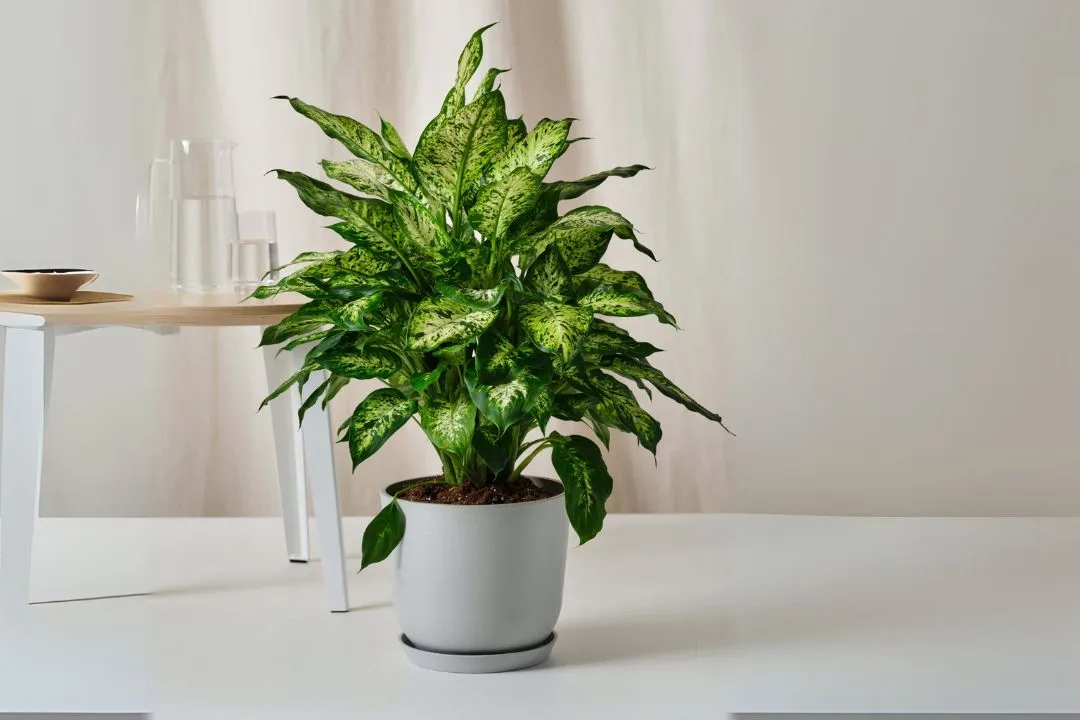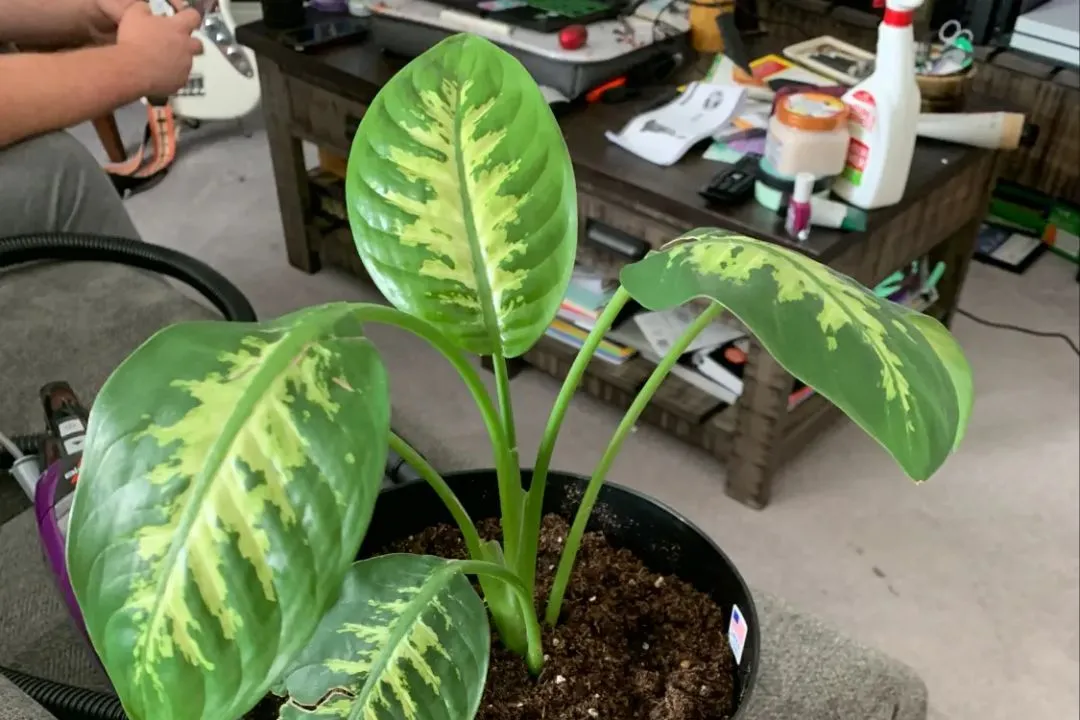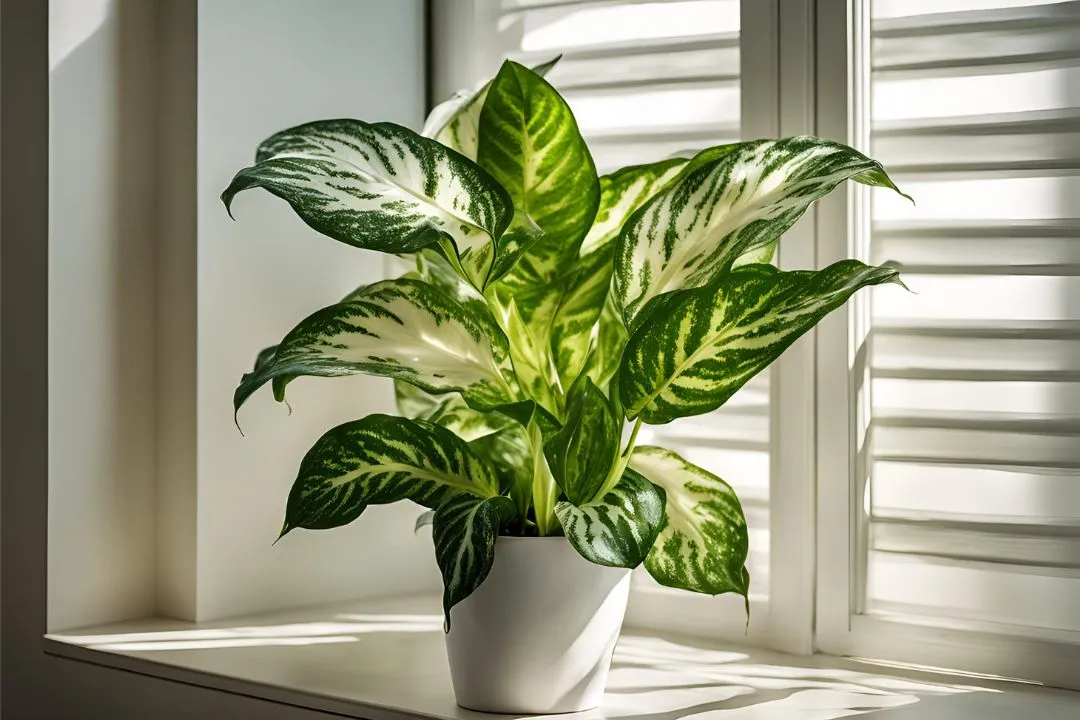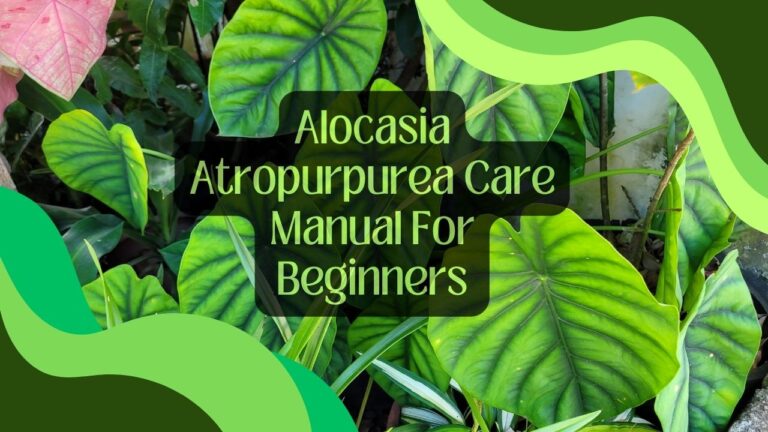An A-Z Guide for Dieffenbachia Plants Care

Dieffenbachia plants, with their striking leaves and easy care, can transform any space into a calming oasis. Their beauty and simplicity make them a favorite among plant enthusiasts.
Wondering how to care for Dieffenbachia plants? These tropical beauties thrive with the right light, water, and care. They’re relatively low-maintenance, making them perfect for both beginners and seasoned plant parents. So, be sure about watering, fertilizing, pruning, and repotting right!
In this article, we’ll guide you through everything you need to know. We’ll cover light, watering, fertilizing, temperature, humidity, pruning, and repotting. Let’s dive in and help your Dieffenbachia plants to thrive!
Table of Contents
Dieffenbachia Plants in A Nutshell

Dieffenbachia, also known as dumb cane, is a popular houseplant known for its large, attractive leaves. These plants can add a touch of tropical beauty to your home with their striking green and white foliage. Below is a quick profile of the Dieffenbachia plant:
| Characteristic | Description |
| Common Name | Dumb Cane |
| Botanical Name | Dieffenbachia spp. |
| Family | Araceae |
| Plant Type | Perennial |
| Mature Size | 3-6 feet tall, 1-3 feet wide |
| Sun Exposure | Indirect light |
| Soil Type | Well-draining, potting mix |
| Soil pH | Slightly acidic to neutral (6.1-7.0) |
| Bloom Time | Rarely blooms indoors |
| Flower Color | Greenish-white (if it blooms) |
| Hardiness Zones | 10-12 (USDA) |
| Native Area | Central and South America |
How to Care For Dieffenbachia Plants

Ready to take proper care of your Dieffenbachia plants? Here’s a complete guide to care for your plant –
How Much Light Does a Dieffenbachia Need?
Dieffenbachia thrives in bright, indirect light. They can tolerate lower light levels, but their growth might slow down. Here are some tips to ensure your plant gets the right amount of light:
- Indirect Light: Place your plant near a window with filtered sunlight.
- Avoid Direct Sun: Direct sunlight can scorch the leaves.
- Artificial Light: If your home lacks natural light, use fluorescent or LED grow lights.
How Often Should You Water Dieffenbachia?
Watering Dieffenbachia correctly is crucial for its health. Here’s how to do it:
- Regular Watering: Water when the top inch of soil feels dry. Stick your finger into the soil to check.
- Avoid Overwatering: Too much water can cause root rot. Make sure the pot has drainage holes.
- Humidity: Dieffenbachia loves humidity. Mist the leaves or place a humidifier nearby.
What Temperature and Humidity Does Dieffenbachia Prefer?
Dieffenbachia prefers warm, humid environments. Here’s what you need to know:
- Temperature: Keep the plant in a room that stays between 65-75°F (18-24°C).
- Avoid Cold Drafts: Keep it away from windows or doors where cold drafts might occur.
- Humidity: Aim for 60% humidity. If the air is dry, use a pebble tray or humidifier.
How Do You Fertilize Dieffenbachia?
Fertilizing Dieffenbachia helps it grow strong and healthy. Follow these steps:
- Type of Fertilizer: Use a balanced liquid fertilizer, diluted to half strength.
- Frequency: Fertilize every 4-6 weeks during the growing season (spring and summer).
- Avoid Over-fertilizing: Too much fertilizer can burn the roots. Less is more.
When and How to Prune Dieffenbachia?

Pruning your Dieffenbachia plant is key to keeping it healthy and looking good. Here’s how you can do it easily and effectively.
Tools Needed
Start by gathering your tools. You’ll need clean, sharp scissors or pruning shears. Clean tools prevent disease spread.
Remove Dead Leaves
Look for any yellow or brown leaves. Cut them off at the base. Removing dead leaves helps the plant focus on new growth.
Encourage Growth
Trim the tips of the stems. This encourages the plant to grow bushier, not just taller.
Safety First
Always wear gloves when pruning. The sap from Dieffenbachia can irritate your skin. After pruning, wash your hands well.
Steps to Prune:
Let’s follow the step-by-step guide to prune your Dieffenbachia plant –
- Identify Dead Leaves: Find any leaves that are yellow or brown. These are the ones you’ll cut off first.
- Cut at the Base: Use your scissors or shears to cut the dead leaves at their base. This keeps the plant neat and healthy.
- Trim the Tips: Look for long stems and trim the tips. This makes the plant grow more branches, making it fuller.
- Clean Up: After pruning, clean your tools with rubbing alcohol. This prevents the spreading of plant diseases.
How Do You Pot and Repot Dieffenbachia?

Potting and repotting your Dieffenbachia is important for its growth. Here’s a simple guide to help you through the process.
When to Repot
Repot your Dieffenbachia every 2-3 years. You should also repot when the roots outgrow the current pot.
Choosing a Pot
Pick a pot that’s 1-2 inches larger in diameter than the current one. This gives the roots more room to grow.
Soil Mix
Use a well-draining potting soil. Good drainage is crucial to prevent root rot.
Steps to Repot
Follow the given steps to repot –
- Remove the Plant: Gently take the plant out of its current pot. Be careful not to damage the roots.
- Shake Off Soil: Shake off excess soil from the roots. This helps you see the roots clearly.
- Inspect Roots: Check the roots for any signs of rot or damage. Healthy roots are white and firm.
- Prepare the New Pot: Place a layer of fresh soil in the new pot. This forms the base for the plant.
- Place the Plant: Put the plant in the new pot. Make sure it’s centered.
- Fill with Soil: Add fresh soil around the plant. Press it down gently to remove air pockets.
- Water Thoroughly: Water the plant well after repotting. This helps settle the soil around the roots.
- Place in Indirect Light: Put the plant in a spot with indirect light. Too much direct sunlight can harm the freshly repotted plant.
Recommended Articles:
FAQs
Here are some of the queries about Dieffenbachia plants gathered from the Internet. I hope these assist you align your knowledge in this area.
Q: Is Dieffenbachia Safe for Pets?
No, Dieffenbachia is toxic to pets and humans if ingested. Keep it out of reach of children and animals.
Q: How Fast Does Dieffenbachia Grow?
Dieffenbachia grows moderately fast, especially in ideal conditions. You can expect noticeable growth within a few months.
Q: Can Dieffenbachia Be Grown Outdoors?
Yes, in USDA zones 10-12. Otherwise, it’s best kept as an indoor plant.
Q: Why Are My Dieffenbachia’s Leaves Drooping?
Drooping leaves can be a sign of overwatering, underwatering, or insufficient light. Check the soil moisture and light conditions.
Q: How Do I Propagate Dieffenbachia?
You can propagate Dieffenbachia through stem cuttings. Cut a healthy stem and place it in water or soil to root.
Conclusion
Caring for Dieffenbachia plants is a rewarding experience. With the right light, water, and a bit of attention, your plant will thrive. Regular pruning and repotting keep it healthy and looking great.
Addressing common problems like yellow leaves or pests ensures your plant stays vibrant. These beautiful plants not only add greenery to your home but also bring a sense of calm and joy. Remember, every bit of care you give returns tenfold in beauty and tranquility.






